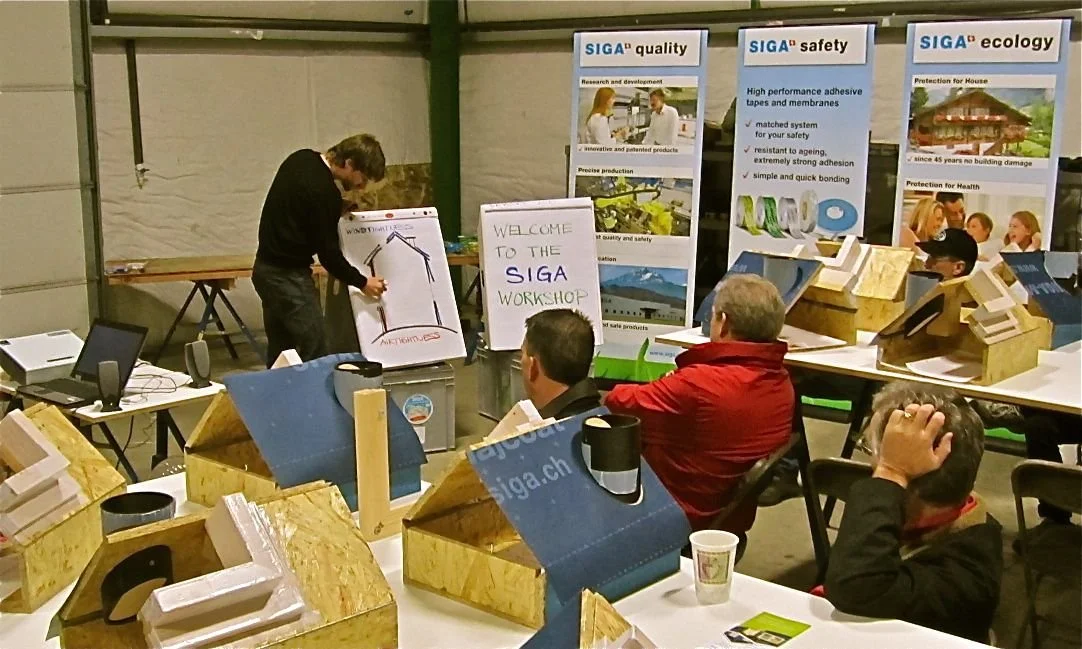Sealing Success: How SIGA Tapes and Membranes Stuck Their Landing in the USA
/albert rooks, CEO of Small planet Supply and WaterDRop Systems.
Small Planet Supply has been a leading distributor of SIGA tapes and membranes in North America longer than any other company. With a SIGA webinar on the schedule this week, we took the opportunity to interview Small Planet Supply Founder and CEO Albert Rooks. He shared how SIGA has influenced his journey and transformed high-performance building practices in North America.
How did you connect with SIGA, and how were you able to sell it in North America?
Dan Whitmore and I were both members of Passive House Northwest and Dan was building his first Passive House project in Seattle. I watched Dan and others in the Passive House Northwest Chapter tackling the challenge: How do we achieve airtightness and create an effective interior air barrier? Stepping back, I began to wonder if there were European products that could help us reach our airtightness goals.
I spent time doing internet searches and found a company called SIGA. I had scheduled a trip to Germany, Austria and Switzerland as part of my Passive House product investigation. I reached out to SIGA to set up a time to meet with one of their representatives. That representative turned out to be Product Manager, Patrick Haacke. Although we couldn’t meet during my trip to Europe, he was scheduled to visit Portland, Oregon, a few months later, so we arranged to meet then.
The fun thing for me about Patrick was that he was a former timber framer, and I was too. We shared that love of handcrafted, large timber joinery, which is what brought him to Portland, Oregon. Later that summer, he shipped over a pallet of samples, and Dan Whitmore, Pete Chramiec, Patrick Haacke and I arranged to meet in a Portland parking garage to “exchange the goods”. It turned out to be an interesting night in that Patrick lost his keys, the car was locked, and we had to essentially break into the car to “steal” these very expensive tapes. As you can imagine, we drew some attention as we tried to break into a minivan in a Portland parking garage late at night
Fast forward, the tapes work great. We found some issues and challenges with applying certain tapes onto OSB. But, on the whole, everything went really well, and I decided to be the first importer in North America. I was really excited.
Patrick Haacke and I met later that year in Vancouver, Washington, where we finalized my first order—a shipment valued at $18,000 (our cost). I went ahead and placed the order.
The first SIGA store was inside one of two non-functional nuclear silos
We received the shipment into our first warehouse, which was located in the abandoned nuclear reactor in Satsop, Washington. I received this pallet of tapes and membranes and promptly thought, “Gee, I'm probably going to own this for the rest of my life. I don't know how I'm going to sell it”. As it turned out it, it sold well.
What was your initial strategy to get SIGA into the North American market?
My initial strategy to get SIGA into the market was really networking, and the best networking for the developing Passive House community was at the Passive House conferences, both small regional and the larger national conferences. At the time it was a very tight-knit group. This group of tight-knit people were earnestly looking for new solutions. It was exciting to be at those events and offer new solutions to a market that appreciated it and found it helpful.
SIGA’s usual strategy is to hold workshops to demonstrate how to correctly use their tapes and membranes to create an airtight envelope. How did you begin offering this type of workshop here and where were the first few workshops held?
EARLY NORTH AMERICAN SIGA WORKSHOP USING SMALL MODEL HOUSES
It’s definitely SIGA’s strategy to introduce the product by holding workshops to train people on how to use the materials. It was so much fun to hold the first workshop. Since we were just starting out, we started with small building models for our first workshop. Patrick Haacke, and a recent new arrival from Switzerland, Michael Brogle, came to Seattle to set up the first workshop. The first group was such an energized group and totally fun. It included leading members of Passive House and many of the board members of the Northwest Ecobuilding Guild, who many were crossover members with Passive House Northwest. The workshop was held at the Finney Ridge Neighborhood Center near Green Lake in Seattle. It was a location were the EcoBuilding Guild typically held its monthly meetings. At the workshop, the whole group was learned to build a solid air barrier with entirely new materials and entirely new approaches using these small building models.
After that initial Seattle workshop, I rented a trailer and packed all the SIGA training materials in it and went on the road, holding workshops all over the Northwest. Everywhere I went I would just meet the most interesting, fun people, which was the best part of the work.
How has SIGA and Small Planet evolved since the introduction of the first rolls of tape in North America?
What started as a small initial order of tapes and membranes grew into products relied upon by Passive House Builders all over North America. Small Planet Supply started as the first dealer and importer, and eventually, SIGA decided to enter the North American market directly. Then we became both a dealer and their logistics agent. During that time, we managed all of SIGA's inventory, fulfilling orders and shipping products to their North American dealers on their behalf.
As product sales increased, SIGA was able to take over those operations themselves, after setting up their own staff and companies in both the USA and Canada. Small Planet Supply still sells SIGA but freeing up logistics has allowed us to focus on bringing in even more energy-efficient products into the North American market.
What did you initially find appealing about the SIGA products?
Patrick Haacke, SIGA. Photo courtesy of SIGA.
What I found initially appealing about the SIGA products were that they were just so darn good. Nobody here in the USA had ever seen anything like it. Nobody had ever seen a tape that was so sticky. For many of us it was our first time learning about acrylic adhesives, and so we started to understand what made them so well-suited for creating an airtight build.
I also liked the longevity of the tape, how the bond worked, and how it could easily adhere to the various materials that you find in construction. SIGA sticks so well, it got to be a joke. During this time, a lot of folks were spending time on Green Building Advisor with Martin Holliday, who is just no slouch when it comes to evaluating product and applications. We exchanged some funny emails and videos about tape getting where it doesn't belong. And eventually he wound up doing a very unofficial tape test in his barn in upper New England. Between that and other activities, the idea of using SIGA began to catch like a wildfire, mostly because it was such a different product than anybody had really encountered before.











